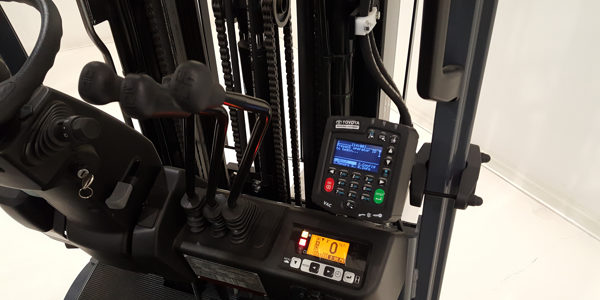RFID earns MVP honors for asset tracking

Distribution center managers have long had a conflicted relationship with radio-frequency identification (RFID) technology. Like a hotshot high school player drafted by the big leagues only to fade into relative obscurity, the technology has never quite lived up to its glittering promise.
RFID burst onto the scene in 2003, swaggering into the stadium when Wal-Mart named the technology its starting pitcher in a bold effort to track items throughout its distribution network. But the technology failed to live up to its promise, largely because the high cost of RFID tags and readers put it out of reach of all but the biggest corporations.
Demoted to the minors, RFID has been clawing its way back into the supply chain big leagues ever since, finding success in specialty applications such as tracking high-priced fashion apparel, electronics, and pharmaceuticals. Despite those wins, RFID continues to be dogged by the perception that tags and readers will remain too expensive for widespread use until they reach mass production.
"That was the challenge when we first got into the industry almost 25 years ago, and it still exists today," said Ken Ehrman, CEO of I.D. Systems, a supplier of asset tracking solutions. "Tags are very expensive compared to bar codes, so there's a 'chicken and egg' problem; if the costs were lower, the volume would be there, but without the volume, you can't drive down the cost."
Some say a solution to this existential dilemma has been under users' noses the whole time. Instead of waiting around for prices to drop to the point where the technology is cheap enough for item-level inventory tagging—a task at which bar codes already excel—warehouse and DC managers could use RFID to track much more valuable stuff—the supply chain assets (think lift trucks, tractor chassis, and handheld computers) that make a distribution center tick.
TRACKING CRITICAL ASSETSIn asset management, RFID may have finally found its niche where supply chain operations are concerned. Rather than simply tracking inventory, it can be put to higher uses, like serving as the enabling technology for sophisticated data collection initiatives.
As for what types of assets DCs are tagging, that varies all over the map. While some operations tag assets like returnable containers that are routinely sent off site, others track items that are intended to remain inside a facility, like manufacturing tools or IT equipment. "One of the biggest problems is [warehouse workers] losing handhelds; they put it on a pallet and lose it when the pallet gets loaded and moves," said Tom O'Boyle, director of RFID at Barcoding Inc., a Baltimore-based company that specializes in software and hardware for bar coding, RFID, and wireless systems.
As a case in point, O'Boyle cites the example of a customer that was losing 20 percent of its handheld bar-code scanners every year, running up a hefty replacement tab for the units, which cost $1,500 to $2,000 apiece. "And more important than the replacement cost is the ability to outfit the next shift," said O'Boyle. "They need the handhelds for picking, packing, and putaway." Balanced against those two costs, the customer easily justified its investment in RFID tags to track its assets.
Another of Barcoding's customers turned to RFID to help it keep tabs on the tractors used to move heavy rolls of paper around a facility. "These are big pieces of equipment, but [the client] often couldn't find them in the 3 million-square-foot facility because certain workers would hide the vehicle by parking it behind other equipment," O'Boyle said. "That way, when [the driver] came back for his next shift, no one would have adjusted his seat, moved his mirrors, or changed his radio station."
NEXT-GEN RFIDUntil recently, companies looking to track supply chain assets had just two choices when it came to RFID tags. The first option was the passive RFID tag, which is a relatively inexpensive item costing a dollar or two. The tag cost is only part of the story, however, since users also need an infrastructure of readers and software to gather the information encoded in the tags. That's because passive tags lack an internal power source and cannot transmit a signal. In order to collect the tags' data, users must scan them with a handheld reader within a 10-foot range or pass them through a fixed-read zone like a tollbooth pOréal.
This Bluetooth Low Energy (BLE) beacon is part of Barcoding Inc.'s Active Asset Tracker Solution, which tracks items using the Internet of Things.
Option two was the active RFID tag, which costs anywhere from $25 to $150. Active tags, which contain their own power supply, are capable of transmitting signals that can be read from as far as 50 to 100 feet away. Those signals can be detected by stationary readers with overlapping coverage areas, then triangulated to pin down the tag's location.
Now, a third option is emerging that combines some of the best features of active and passive tags. Known as Bluetooth Low Energy (BLE), the technology was originally developed for smartphones, so the signal can be read by consumer devices that run on the iOS and Android operating systems.
The standard was first deployed for "location-aware services," such as retail applications in which tags affixed to store shelves beam discount offers to the smartphones of passing shoppers. But BLE tags have since been ruggedized to meet industrial standards for shock, temperature, vibration, and battery life. And since they communicate on the common wireless standard used in consumer mobile devices, they require far less infrastructure investment than other tracking technologies do.
BLE tags can communicate limited information, but their falling price will soon open up new opportunities in supply chain asset tracking, such as keeping track of specialized tools or even keys to equipment. "We're at the leading edge of that technology now, so they cost $15 or $20 or $25 each, but they are at the highest point," O'Boyle said. "My guess is that in three to five years, they will be under $10."
E-COMMERCE DRIVES NEED FOR ASSET TRACKINGInterest in RFID and BLE is particularly strong among retail industry distribution operations that are struggling to fill e-commerce orders within ever-tighter time windows. "Fulfillment centers were designed with an order turnaround time of X, and now they want to drive that to half of X," said Mark Wheeler, director of supply chain services at Zebra Technologies Corp., a supplier of tracking technology.

Nickel-sized RFID tags made by Zebra Technologies Corp. are used to track NFL football players during games.
For these types of facilities, asset tracking is mainly a matter of ensuring that workers can lay their hands on the warehouse tools and equipment they need in their daily operations—items that can be easily misplaced when a DC is running at full steam. A shortage of even the most basic totes, carts, or pallets can throw a wrench in the works of a fast-paced e-commerce fulfillment operation. With its low tag costs, passive RFID offers users a way to improve the tracking of those basic assets.
"Asset management is one of the key applications," said Wheeler. "Users want to control their assets, keep track of where they are, and reduce shrink of assets and the inventory they're associated with."
In contrast, active RFID is a better match for a facility that's looking to track moving assets both inside the facility and out in the yard. "This is great for classic warehouse applications where real-time location is a step up from the level of visibility you have with warehouse management systems (WMS), which only know the last location you scanned," Wheeler said. "When we really know the location of lift trucks and people, it can lead to improved safety, productivity, and workflow."
SENSORS MAKE TAGS SMARTERIn response to the growing interest in RFID-enabled asset tracking, some vendors are shifting their focus from ways of making tags cheaper to ways of making tags smarter. That is, they're manufacturing tags that are capable of determining much more about each asset than just its location. As part of that effort, RFID suppliers have begun outfitting their tags with sensors, software, microprocessors, and batteries.
Loaded with extras, such an RFID tag could be the size of a TV remote and cost anywhere from $250 to more than $1,000, said I.D. Systems' Ehrman. But the tag's enhanced capabilities would more than offset the extra cost, he argues. "If a Wal-Mart truck is sitting there with a loaded trailer and the door is opened, we will notice," Ehrman said. "Or if it's been sitting at the DC for more than two hours, we could send a message to the manager that it is outside its operating parameters."
Typically deployed on large assets like lift trucks, intermodal containers, trailers, chassis, and rental cars, these tags can bypass handheld readers, beaming data directly back to a central network via Wi-Fi, cellular network, or satellite signal. In line with the growing popularity of the Internet of Things, this method tracks asset data through a tag-to-system model instead of the standard tag-to-reader approach.
Among other data, these long-range tags can collect information on odometer mileage, fleet usage, dwell time, and transit time for moving assets such as forklifts and chassis. By graphing the results and comparing the statistics with industry benchmarks, users can analyze the data with an eye toward eliminating extraneous vehicles, scheduling needed maintenance, and identifying savings opportunities.
"The bottom line is, these [trucks and other assets] are carrying the inventory," Ehrman said. "And ultimately, the cost of tracking these assets will continue to go down, so we will go from tracking the highest of the high-value assets to lower- and lower-value assets."
Related Articles

Copyright ©2024. All Rights ReservedDesign, CMS, Hosting & Web Development :: ePublishing